Social Links Widget
Click here to edit the Social Media Links settings. This text will not be visible on the front end.
5 Ways to Prepare Your Trees Before Listing Your Home For Sale
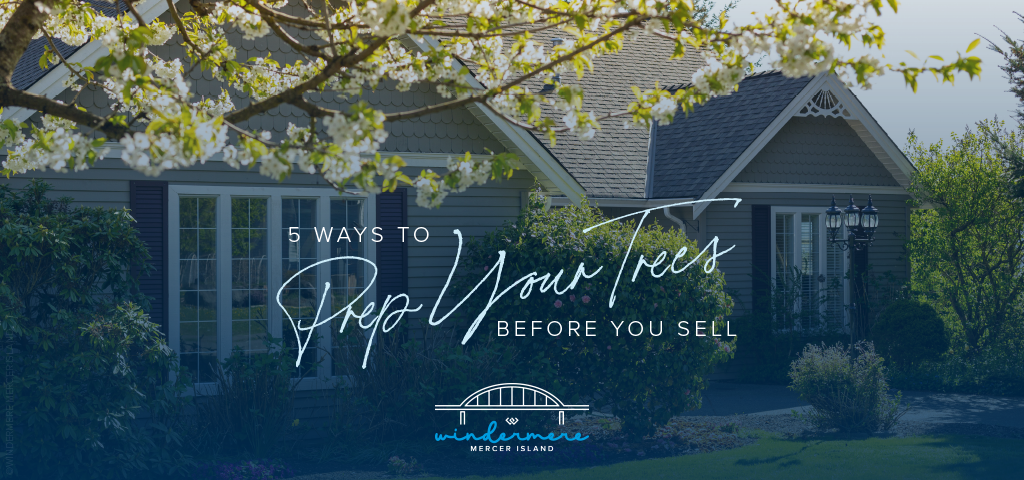
Most sellers know that some strategic home prep—and hiring the right broker—are key to getting you the highest possible price for your home (you can find tips in my Complete Checklist for getting ready to sell). However, one of the items on the list definitely deserves a deeper dive: Tree Care. Many homeowners are not aware that a targeted dose of tree care can go a long way in supporting the final sale value of your home.
According to a review of various studies completed by Dr. Kathleen L. Wolf at the University of Washington, homes with trees see a roughly 7% price premium compared to comparable homes without trees. If you’re looking at listing your home for $850,000, that 7% premium could mean almost $60,000 more in your pocket! Not a bad return on investment for a couple grand in tree work spend upfront.
Now look—if you’re more than 10 years away from selling your home, the #1 tip would be to plant a couple new trees in your front yard (in coordination with an arborist to help you with species selection and location selection). That way they grow into feature pieces of your landscape by the time you’re selling. But even if you’re planning to sell in the next 2 to 3 months, there is still a lot you can do to capture that tree premium with your existing trees and shrubs!
We partnered with the ISA-Certified Arborists at Blooma Tree Experts, a locally-owned and operated tree care contractor that has worked on many Windermere-listed or managed properties, to provide you with clear guidance on how to prep your home’s trees and shrubs for sale.
Read below for five tips for getting your trees and landscape in order before listing your home.
1. Complete Clearance Trimming
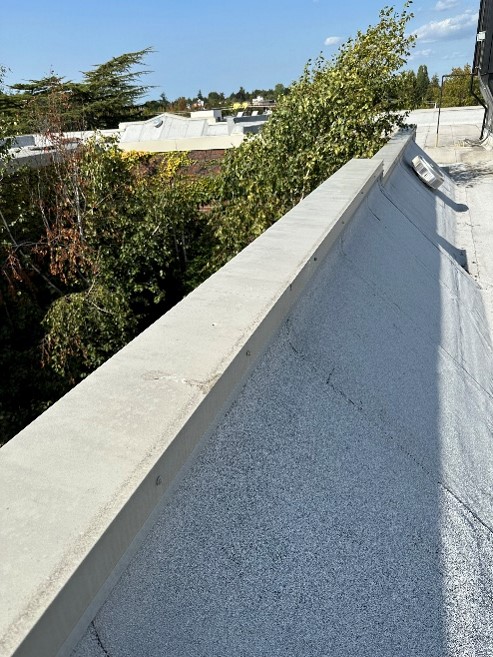
The upper canopy of the birch tree in this building’s courtyard could become a rat-to-roof highway.
Did you know that rats can jump as far as four to six feet from a tree branch onto your roof? While not all tree branches can be trimmed to create that much clearance, ask your arborist to provide 4-6 feet of roof and building clearance all around your home regardless of if you’re selling your home or not.
Similarly, some basic walkway, driveway, sidewalk, and roadway clearance trimming will set up your property to maximize curb appeal. You want your trees to provide a beautiful canopy to your property, not feel like they are bogging down the space.
This work is especially important before listing your home. Why? First, depending on the buyer’s insurance coverage, it may be a requirement to have clearance from all tree branches as part of the roof coverage—don’t let this become a closing delay in your home sale. Second, creating that room around the building and walkways allows it to stand out and create a feeling of space. You still have the beautiful trees framing your home, but the property won’t feel crowded in or cramped.
This is a quick and easy maintenance step that any qualified arborist should be able to handle for you.
2. Complete Selective Pruning for Light on any Trees Closer to the Home
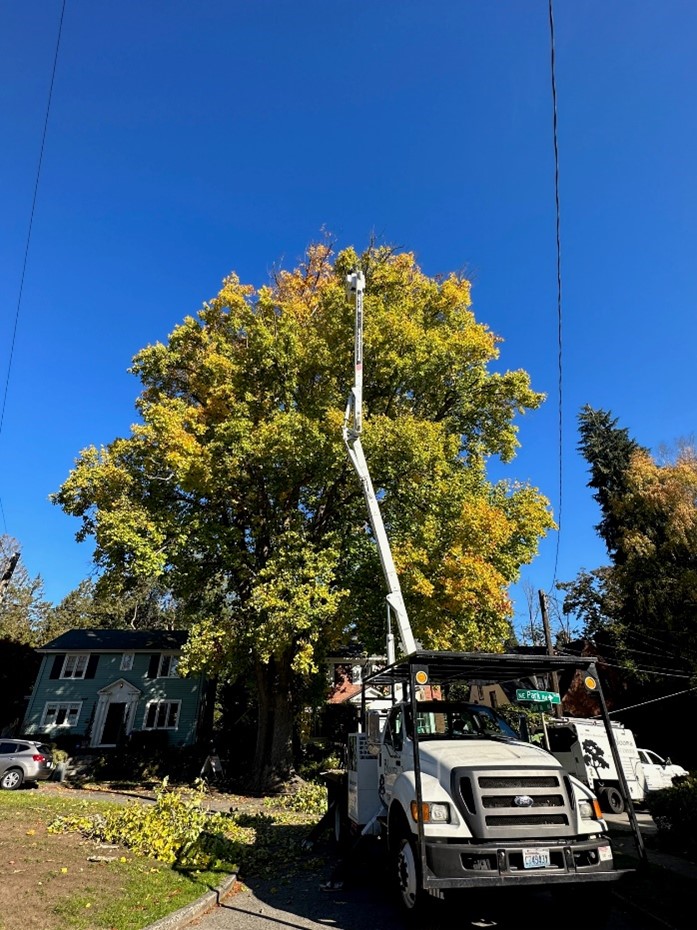
No need to prune the whole tree excessively – in fact, that’s bad for the tree. Instead, selective pruning of dead branches that create unnecessary shade can efficiently open up light on the houses below.
You’ve seen it before—a home shrouded in darkness due to a row of massive trees towering over one side. This shadow, particularly if on the south or west sides of the home, can make the home feel darker and less welcoming.
This can be easily resolved without major pruning. An experienced, qualified arborist can complete selective pruning, which means they look for the ideal branches to take out to promote light passing through. They’ll focus on dead, dying, and crossing branches that are either safety risks or don’t serve much purpose. This doesn’t require extensive pruning, which helps manage the cost down, but still promotes the overall feel of your home, especially given Seattle’s overcast and low-light climate.
3. Hedges – Get Them In Order
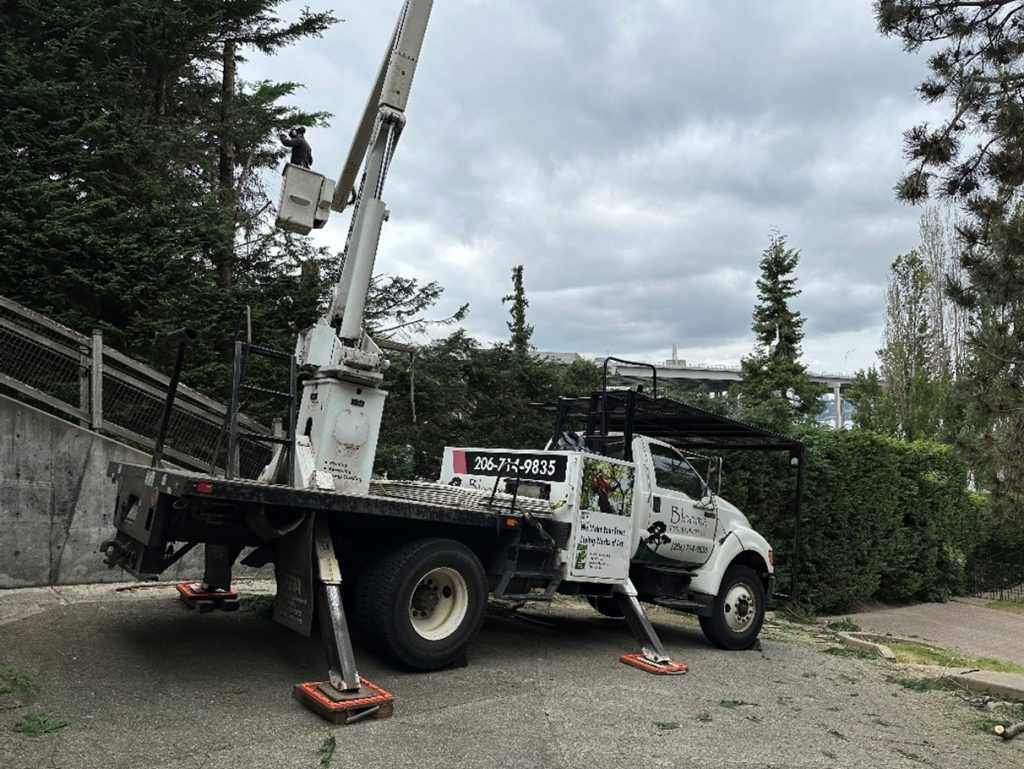
A large hedge being reduced for the first time to a manageable height – “after” on the right, “before” on the left as the team continues to work.
Rows of hedge trees provide beautiful natural privacy walls—unless they are unruly, with unlined tops and lots of bushy growth in all directions. When the hedge looks scary, a new homebuyer is thinking, “Uh oh, this looks like a maintenance nightmare.” When they see a properly maintained hedge, they actually appreciate the value the hedge brings to the home as a complete property.
This is crucial to get done early, at least 2 months before listing if possible. When you have hedge trimming done, it will not look great at first; there will be unsightly sticks showing. However, hedge trees grow FAST—these spots will fill in quickly with new foliage and the whole hedge will serve as an attractive feature.
If you don’t have enough time pre-listing to do the full hedge trimming work, ask your arborist or landscaping team to do a light trim and specify that you don’t want any brown showing from the inside branches. No guarantees on that front—each tree within a hedge grows differently, so if you make a straight line, you may end up with slightly different looks—but this will be a quicker and cheaper option to at least tidy up the appearance pre-listing. You’d rather the hedge look like a bit-too-short buzz cut (at least it’s clean!), rather than a poorly-managed mullet.
If you are a year or more away from listing, then it may be worth having your tree care contractor do the full hedge work, including setting the ideal height for your hedge to where it should be going forward. This is chainsaw work (not hedge trimmer work) and costs more money, but will allow you to actually maintain the shape of the hedge in a manner that is visually appealing to future homebuyers.
In the picture above, you can see exactly how different a hedge can look before a new line is set (left side of the picture) and how much more manageable it looks after the new line is set (right side of the picture).
You just want to do this work at least 6-12 months before listing to give the greenery time to grow back in.
4. Complete Aesthetic Tree & Shrub Pruning + Soil Amendments
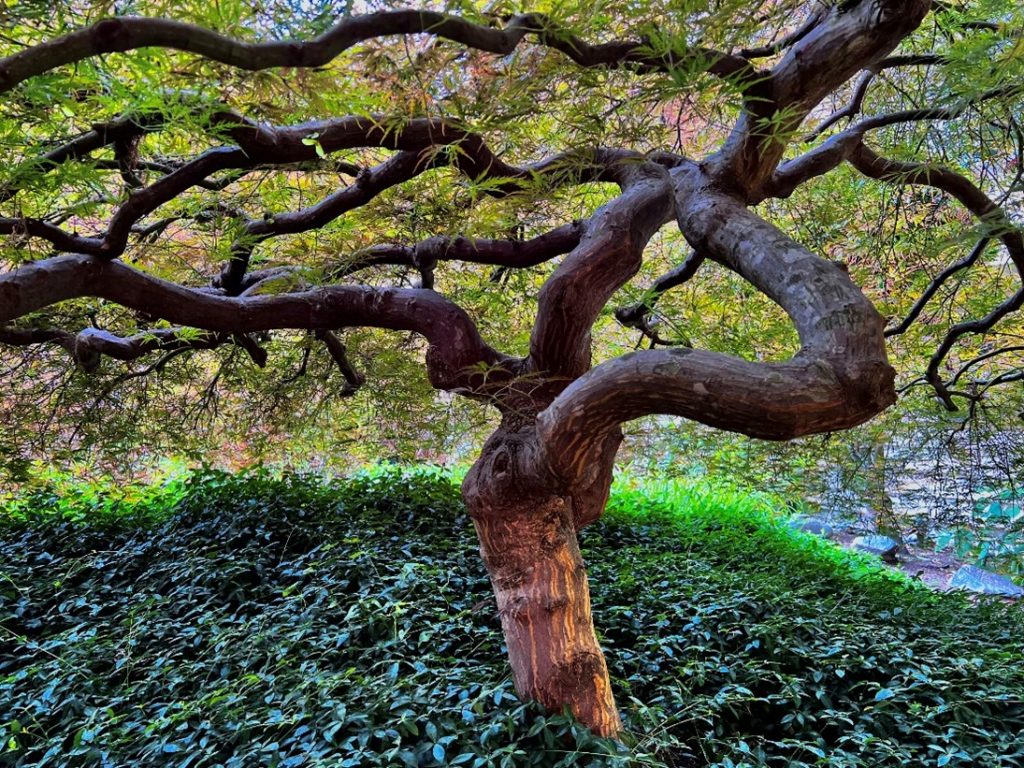
A Japanese Maple pruned to showcase its intricate internal structure.
Your front yard trees, shrubs and bushes are like your home’s first impression on potential buyers—let’s make them pop.
For example, if you have a Japanese Maple or native Dogwood tree in your front yard, you want those special trees to be a centerpiece that wows potential homebuyers. If you’ve got the lower canopy of a mature tree growing straight into these ornamental trees, you may want to complete some crown raising pruning on the larger tree to really help your ornamentals stand out. Basically, you want to create the “I bought the house because of this tree” sentiment for a homebuyer—investing in a fine tree pruning specialist can go a long way here.
If your front yard is more shrubs and bushes, a light application of fertilizer, water, and other organic soil amendments can promote your plants’ vigor, flowering intensity, and color. You’re basically giving your shrubs a little extra food to give them that boost of energy going into home listing season. Whether it’s flowering bushes showing off stunning colors, or just bright greens on foliage, it all helps paint the scene. The best part is that it doesn’t take much to help the flowers and leaves show vigor—a tree and plant healthcare application like this should cost less than $200. Combine this with some light pruning for deadwood removal to help de-clutter the inside of the bushes. Your homebuyer should understand how bright and pretty the front yard landscape can look after a long, dreary Seattle winter.
Further, a little DIY tip—as flowers die on the stem, you can manually remove them yourself (aka “deadheading”). The plant wants to move on from flowers into seeds. If you interrupt that sequence, the plant will want to keep pushing out more flowers.
Don’t forget to water your shrubs and bushes well—more than you think you should. Avoid watering directly on the foliage or right against the trunks of the shrubs. Instead, try to water around the exterior edges of the shrub, as that’s where the most important roots are. Water slowly and deeply—it’s better to water a few times per day rather than a huge amount all at once.
Lastly, if you have unsightly stumps in your yard from prior tree removals, now’s the time to deal with those eyesores. Stump grinding can be expensive, but it fundamentally alters one of your landscape beds from “Oh, that’s ugly and a future cost” to “Wow, I wonder what flowers we could plant here!” for your potential homebuyer.
5. Health & Safety Management
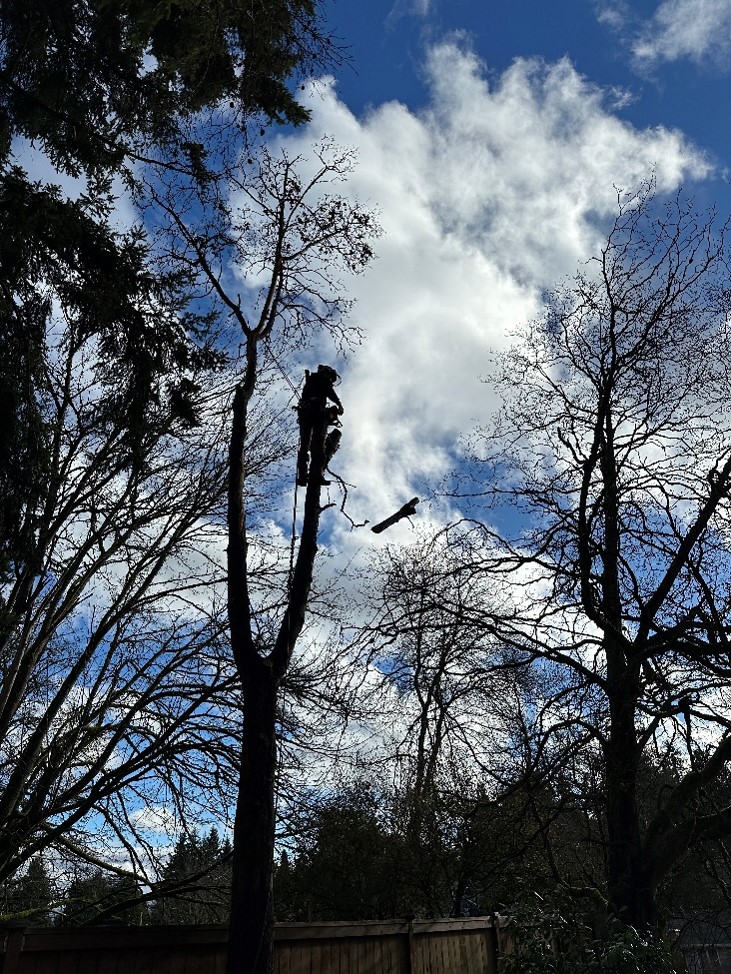
An ISA-Certified Arborist removing a dead tree in a client’s front driveway, which would be an immediate eyesore for a potential homebuyer.
No homebuyer will be excited to buy a home with an obvious problem facing them the day after closing. If you have a furnace about to die, you know it’s going to impact your offer price. It may scare away a buyer who worries about all the other appliances that may be on their last legs or poorly-maintained.
Your yard is no different; an obviously dead, dying, or diseased tree could be interpreted by buyers as a signal that the home wasn’t well-maintained in general. Some may just not be interested in the headache of dealing with the tree removal right after they stomached all the closing costs—as a result, they may decline to write an offer, or overestimate the cost of the tree removal and discount their offer by too much.
Similarly, if you have large, mature trees that haven’t been pruned in years, it may be prudent to complete “deadwood pruning” where qualified arborists remove dead, dying, diseased and hazardous branches. They can also remove hangers (sometimes called “widow makers”) and address any structural defects in the tree’s architecture.
To be clear, this is a more costly part of the prep process, but there’s likely an immediate ROI on dealing with it yourself before going on the market. Please note: for any tree removal (and larger tree pruning), you should hire a qualified arborist, ideally with an ISA-Certified Arborist on the crew. If you live in the City of Seattle, your contractor should be able to provide you with their Registered Tree Service Provider license number.
Give yourself time to handle this issue, as city permitting for tree removals can often create a 2-3-month lead time even for dead trees.
Conclusion
Your home is likely your largest investment and savings. Don’t shortchange yourself when it comes time to sell!
For more information on preparing to sell your home, check out my “Preparing to Sell Your Home” Checklist—and when you get to the Yard section, come back to this list of tips and see what makes sense for your property!
We’d like to give a BIG shout out to the Blooma Tree Experts team for assisting us in preparing these tree care pre-listing tips for you. They’d be happy to support you in your tree care needs, starting with a complimentary consultation with an ISA-Certified Arborist.

We earn the trust and loyalty of our brokers and clients by doing real estate exceptionally well. The leader in our market, we deliver client-focused service in an authentic, collaborative, and transparent manner and with the unmatched knowledge and expertise that comes from decades of experience.
© Copyright 2024, Windermere Real Estate/Mercer Island.
 Facebook
Facebook
 X
X
 Pinterest
Pinterest
 Copy Link
Copy Link